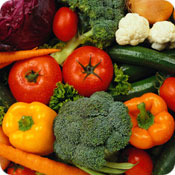 Change... Change... Change! Just when you and your baby have the breast or bottle-feeding skills mastered, it's time to move on to solid foods. And the questions start coming again. How much? How often? What kind? Food allergies? Choking concerns? Wouldn't it be nice if your baby came with feeding directions? Do not worry; starting solid foods is just another parenting adventure. By using the following tips and feeding guidelines, you and your infant will be mastering the high chair in no time.
Change... Change... Change! Just when you and your baby have the breast or bottle-feeding skills mastered, it's time to move on to solid foods. And the questions start coming again. How much? How often? What kind? Food allergies? Choking concerns? Wouldn't it be nice if your baby came with feeding directions? Do not worry; starting solid foods is just another parenting adventure. By using the following tips and feeding guidelines, you and your infant will be mastering the high chair in no time.
Ready, Set, Go!
Your baby will be on breast milk or infant formula for the first year of life. However, most babies are ready to start solid foods between four and six months of age. But do not rely completely on the calendar. Your baby needs to be physically and developmentally ready for solid foods. There is no need to rush. Solid foods will not help your baby sleep through the night. So never put solid foods into a bottle or feeding device. Solid foods fed too early are hard to digest and can cause food sensitivities or colic. Remember that each baby is special. Your baby's appetite, growth and development will help you and your baby's doctor decide when to start other foods. Watch for these readiness clues.
- Your baby can sit with little support in a high chair or on your lap. Your baby can control his head movements.
- Your baby can move food from the front to the back of the mouth. A baby younger than four months does not have enough control of the tongue to handle food fed from a spoon and the food is pushed out of the mouth. As your baby develops, the tongue becomes more coordinated and moves back and forth. This allows your baby to swallow foods from a spoon.
- Does your baby show an interest in the foods you are eating? As your baby watches you, she is learning. Try some iron-fortified infant rice cereal. If your baby doesn't seem interested, wait a few weeks and try again. Never force your baby to eat solid foods.
- Has your baby's weight doubled since birth?
4-6 Months
STEP 1: Iron fortified infant cereal
The first big step when starting solids at 4-6 months is to feed iron-fortified infant rice cereal from a spoon. It is easy to digest and an important source of iron. It is a big adventure for both you and your baby that encourages chewing and swallowing motions needed for healthy jaw and tooth development. It may be messy, but a step toward independence and learning for your infant.
- Pick a time when your baby is relaxed and well-rested.
- Mix 1-3 teaspoons of dry, iron-fortified, infant rice cereal with expressed breast milk, formula, or water until it is thin and smooth. One part cereal to four parts liquid usually works well in the beginning. When starting a new food, always watch for signs of food sensitivity, such as diarrhea, wheezing, rash, or vomiting. Contact your baby's doctor should this occur.
- Have your baby sitting with support in a high chair or on your lap. Have your baby face forward while eating. This makes swallowing easier and helps avoid choking.
- Use a small baby spoon with a long handle. Put just a little bit of cereal on the tip of the spoon.
- Gradually increase the thickness and amount of cereal until your baby is getting a total of 4-6 tablespoons of cereal each day.
- Do not add sugar, honey, syrups, or other sweeteners to the cereal.
- Relax and make this new eating adventure a good experience. Use your soothing voice while you talk to your baby.
- If your baby refuses the cereal at first, try again in a few days. Remember, the taste and texture of the food is new, as well as the spoon.
- After feeding rice cereal for one month, you may want to try other single ingredient infant cereals, such as barley or oatmeal. After trying all the single ingredient cereals, mixed infant cereal may be used.
STEP 2: Fruits and vegetables
Once your infant is accepting cereal, you are off and running. It is now time to offer strained fruits and vegetables.
- Begin with single ingredient fruits and vegetables.
- Feed only one new strained fruit or vegetable to your baby at a time. Wait 3-5 days and watch for signs of food sensitivity such as skin rash, wheezing, vomiting, or diarrhea.
- Use mixtures of mixed fruit or mixed vegetables only after your baby has tried each one separately. Remember to wait 3- 5 days and watch for signs of food sensitivity.
- Offer your baby 1-2 tablespoons of both a fruit and vegetable, two times a day at first. Slowly work up to 2-3 tablespoons of each.
- Avoid fruit desserts. They have fewer vitamins and minerals than plain fruits and may also add unnecessary calories and ingredients.
- Avoid creamed vegetables and vegetable dinners. They have fewer vitamins and minerals than plain vegetables.
- Have a positive attitude when feeding these new foods to your baby, even if you do not like them yourself. This will help your baby to enjoy a variety of healthy foods.
STEP 3: Meats and lean protein
- Choose pureed, single ingredient meats and protein rich foods. Suggestions include: chicken, beef, pork, turkey, lamb, eggs, cooked beans and lentils. Do not add salt or other seasonings that contain salt.
- Use the single ingredient baby meats. The mixed dinners do not have as much protein or iron.
- Feed only one new meat at a time. Wait 3-5 days and watch for signs of food sensitivity.
- Dried beans that have been cooked and mashed, cottage cheese, yogurt, and mashed tofu are also good meat alternatives for your baby.
- Start with 2 teaspoons of meat and gradually increase the amount until your baby is getting about 2-6 tablespoons each day.
6-8 Months
STEP 4: Fruit juice
Continued ›
|
 Change... Change... Change! Just when you and your baby have the breast or bottle-feeding skills mastered, it's time to move on to solid foods. And the questions start coming again. How much? How often? What kind? Food allergies? Choking concerns? Wouldn't it be nice if your baby came with feeding directions? Do not worry; starting solid foods is just another parenting adventure. By using the following tips and feeding guidelines, you and your infant will be mastering the high chair in no time.
Change... Change... Change! Just when you and your baby have the breast or bottle-feeding skills mastered, it's time to move on to solid foods. And the questions start coming again. How much? How often? What kind? Food allergies? Choking concerns? Wouldn't it be nice if your baby came with feeding directions? Do not worry; starting solid foods is just another parenting adventure. By using the following tips and feeding guidelines, you and your infant will be mastering the high chair in no time.





Member Comments